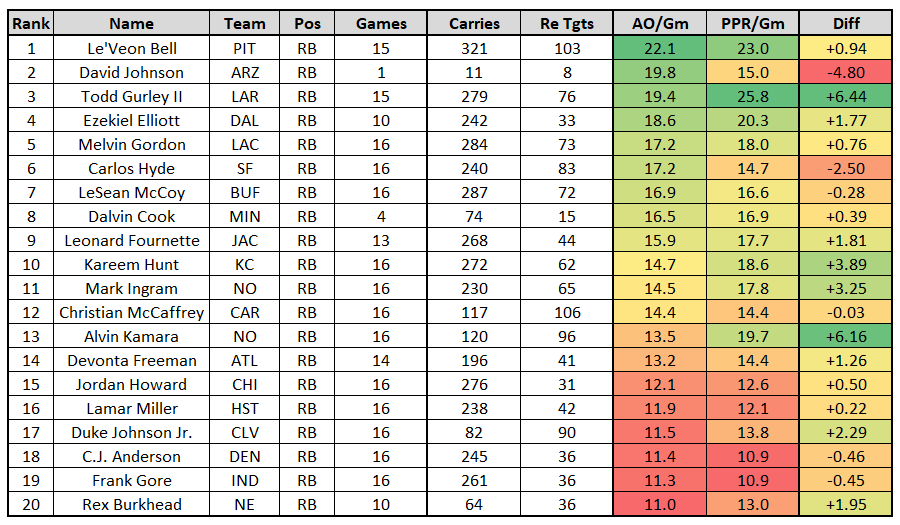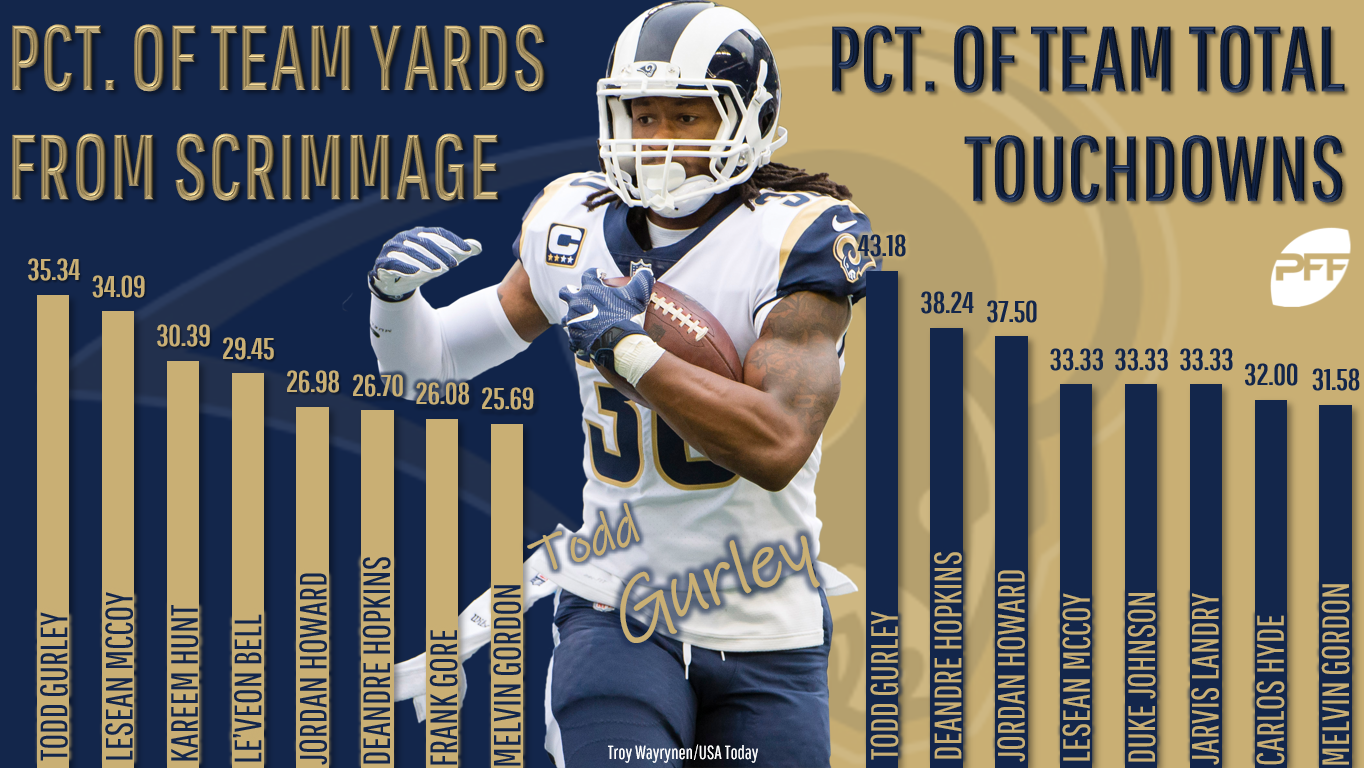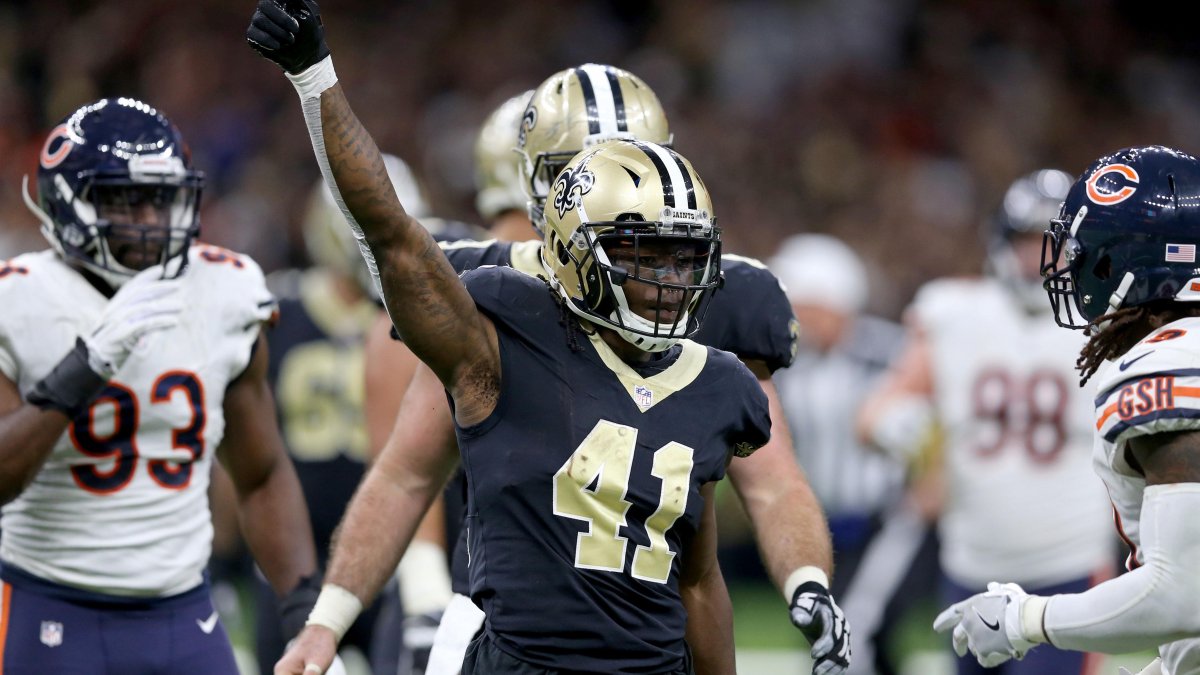If you haven’t reviewed the introduction to my metric, “Actual Opportunity.” I highly suggest looking that over before diving in here.
In this article, I will be taking an in-depth look at the running back position through the lens of this metric and analyzing what this means for the 2018 fantasy season.
As outlined here, the 2017 fantasy season was catastrophic for wide receivers, while running backs hit a new eight-year high in total fantasy points. This was due almost entirely to an uptick in receiving volume and role for running backs, and to the detriment of fantasy wide receivers. As outlined here, running backs might be more risky than wide receivers and tight ends, but this is offset by greater upside. In this article I debated the merits of a “zero RB” draft strategy and detailed my preferred strategy at the position.
See below for a list of the running backs who ranked top-20 from an Actual Opportunity (expected fantasy points) per-game basis.

Notes: All running backs needed to play in at least four games to qualify, with the exception of David Johnson. All references to Actual Opportunity and fantasy points are in terms of PPR scoring.
Le’Veon Bell, Pittsburgh Steelers
Bell averaged 22.1 expected fantasy points per game in 2017. This was 2.7 more than Todd Gurley and the fourth-most by any player at any position this past decade (though Bell’s 2016 season actually ranked higher). Despite this being Bell’s least efficient season (by more traditional stats) since his rookie year, he still outscored his fantasy expectation (0.9 fantasy points per game). However, with running backs, efficiency isn’t as important as volume, and with volume, nothing is as important as raw snaps. Despite missing 18 regular-season games since entering the league (2013), Bell still leads all running backs in total snaps played. Over this stretch he averages 10.4 snaps per game and 3.9 touches per game more than any other qualifying running back. Basically, you’d have to spot the second-closest workhorse running back (LeSean McCoy) an extra free quarter of football per game in order to match Bell. As I outlined here, due to this unparalleled usage and over a large sample (as well as strong efficiency as a bonus), Bell is well worth the first pick in your fantasy drafts.
Todd Gurley, Los Angeles Rams

Gurley averaged 19.4 expected fantasy points per game in 2017, or the ninth-most by any running back this past decade. While his volume was elite, his efficiency was otherworldly. Gurley averaged a whopping 6.4 fantasy points per game over his expectation, or the fourth-most by any running back this past decade. His volume becomes all the more impressive when we also factor in game-script. Despite playing in five (of his 15 games) where the Rams won by over 25 points, Gurley still commanded 85.9 percent of his team’s running snaps, which ranked behind only Bell and Ezekiel Elliott. Gurley was clearly the heart and soul of the Rams’ offense last season, leading the league in percentage of total offensive yards (36.2 percent; Bell was second with 32.2 percent) and percentage of total offensive touchdowns (42.2 percent, DeAndre Hopkins was second with 36.1 percent). There’s little reason to expect usage declines significantly next season and he’s essentially a toss-up with Bell as your first overall pick.
David Johnson, Arizona Cardinals
Johnson totaled 407.8 PPR points in 2016, the ninth-most by any running back all-time – a number no other active running back has ever eclipsed. Johnson averaged 22.6 expected fantasy points per game in 2016, or the most by any player at any position this past decade. If not for a regime change in Arizona, Johnson would be in serious consideration for the first overall pick in 2018 fantasy drafts. Johnson is the only running back on the roster with at least 35 career touches and, with Jermaine Gresham still on the PUP, Larry Fitzgerald is the only active wide receiver or tight end with at least one season of 35 or more receptions. It’s hard to get too excited about the Arizona offense, but perhaps the lack of receiving talent surrounding Johnson means more target volume for Johnson. Targets are far more valuable to fantasy running backs than carries, and Johnson is one of the best receiving running backs in recent memory. He was our highest-graded receiver in 2016 (not just of running backs but of all positions). That year he was also used more like a receiver than any running back in recent memory. In 2016 he lined up as a wide receiver on 33 percent of his routes and totaled 487 air yards, or 200 more than the next-closest running back in any season this past decade.
Ezekiel Elliott, Dallas Cowboys
Elliott ranked third in expected fantasy points per game in 2017 (18.6) after ranking sixth in 2015 (15.5). Elliott has been hyper-efficient over this stretch, totaling 112.3 fantasy points over his expectation, while also being fantasy's most consistent player (by usage) in each of these seasons. What’s particularly shocking is how much room there is for Elliott to grow as a fantasy asset. As outlined here, with just an average receiving workload, Elliott could vault himself among the elite tier of “uberbacks” we just mentioned.
Alvin Kamara, New Orleans Saints
As I tried to show here, Kamara’s 2017 season was one of the most statistically impressive seasons ever recorded by a running back. In total, Kamara outscored his expectation by 98.6 fantasy points, or the third-most by any running back this past decade. The concern for Kamara, is that he either needs to be as unsustainably efficient as he was last year (though, as mentioned in the linked article above, Sean Payton’s running backs have a long history of hyper-efficiency) or volume must drastically improve if he wants to return value at his current ADP (RB5, No. 6 overall). Kamara averaged only 13.5 expected fantasy points per game last season, or only the 12th-most at the position. Mark Ingram, meanwhile, averaged 14.5, or the 10th-most at the position. However, over their final five games, Kamara averaged 17.8 expected fantasy points per game (what would have been fourth-most at the position) while Ingram averaged only 10.7. Based on this, and that Ingram is suspended for the team’s first four games, I think Kamara is appropriately priced, though he is likely due for a massive efficiency regression (our data implies he overachieved in the touchdown-department by 7.6 touchdowns). Hopefully the increase in volume helps to offset this.
Kareem Hunt, Kansas City Chiefs
After Kamara and Gurley (and just ahead of Ingram), Hunt was our third-most-efficient running back, scoring 94.3 fantasy points above his expectation. He ranked ninth in expected fantasy points per game (14.7) and fifth in actual fantasy points per game (18.6). As we detailed here, Hunt appeared hyper-efficient by a number of other metrics and, though Spencer Ware is returning, usage might be better off this year than last.
Melvin Gordon, Los Angeles Chargers
Gordon ranks behind only Bell and Gurley in fantasy points scored over the past three seasons. After finishing third at the position in expected fantasy points per game in 2016 (18.4), Gordon ranked fourth-best last year (17.2). Despite being frequently knocked for poor efficiency numbers, Gordon exceeded his expectation in both years. If factoring in injuries, Gordon's volume was even better than they first appear. Gordon played in all 16 games last year but was listed as questionable six separate times. In those games he averaged only 12.6 expected fantasy points per game but 19.4 in all other games.
Leonard Fournette, Jacksonville Jaguars
I’ve been one of Fournette’s biggest critics since last offseason, when I argued Dalvin Cook was the superior player in college. I doubled down halfway through last season, when I noticed a bulk of Fournette’s efficiency relied on two fluky 75-plus-yard runs. After pointing this out, he averaged just 3.22 yards per carry for the remainder of the season. Fournette also ranked poorly in a number of other per-carry stats. His biggest proponents claimed the issue was constantly running against stacked boxes, but I found even that didn’t help his cause. On top of all these metrics, he graded out just 47th of 57 qualifying running backs last year. All of this being said, he’s locked into a high-end RB1 workload on a Jacksonville Jaguars team that ranked first in run percentage last year and fields one of the league’s best defense (which should frequently yield good field position, game-script, and plenty of scoring opportunities). Fournette ranked eighth in both expected and actual fantasy points per game last season and saw a growing role toward the end of the year, averaging 18.4 expected fantasy points per game across his last six games (including postseason). Even with the aforementioned efficiency concerns, volume is still king, which means Fournette is appropriately priced at ADP (RB9).
Dalvin Cook, Minnesota Vikings
On a small enough sample (min. 70 carries, 59 qualifying), Cook was our fourth-highest-graded runner, ranking seventh in yards per carry (4.78), and 10th in PFF elusive rating (56.1). Cook averaged 16.9 fantasy points per game and 16.5 expected fantasy points per game across four games last season. Despite these numbers being skewed by Cook leaving his final game early in the third quarter, these numbers rank ninth- and seventh-best at the position, respectively. Following his injury, from Week 5 to the end of the season, both Latavius Murray and Jerick McKinnon ranked top-15 in expected and actual fantasy points per game. There’s some concern that usage might not be as strong with Pat Shurmur now coaching the Giants, but Cook is still well worth his ADP (RB10), given his college pedigree and playing for a Minnesota team that should offer plenty of positive game-script and scoring opportunities this year.
Christian McCaffrey, Carolina Panthers
McCaffrey ranked 11th in expected (14.4) and 13th in actual fantasy points per game (14.4) last year. He totaled 172.8 expected fantasy points through the air, which ranked third-most among all running backs this past decade and 24th among wide receivers last year. McCaffrey’s receiving volume might decline a tad with the healthy return of Greg Olsen and after the team drafted D.J. Moore in the first round, but rushing volume has room to improve as well. Head coach Ron Rivera said in June he sees no reason why McCaffrey can't reach 200 carries in 2018. Those (at least) 83 additional carries would be worth an additional 48.1 fantasy points. In July, Rivera said getting McCaffrey the ball 25-30 times per game would “be ideal.” In August, offensive coordinator Norv Turner agreed that number was realistic. That sort of LaDainian Tomlinson-esque workload is extremely improbable, but the message is clear – McCaffrey’s role has room to grow.
McCaffrey struggled as a runner in his rookie year but was at a detriment due to blocking and was still significantly more efficient than Jonathan Stewart. McCaffrey was one of PFF’s six highest-graded runners in each of his last two seasons in college and totaled 6.1 yards per carry over that stretch. I suspect McCaffrey’s floor is where he finished last year while his upside lies among the do-it-all bell-cow running backs typically being selected in the first round. As it stands, McCaffrey is one of my favorite targets in the mid-second round of early drafts.
Carlos Hyde, Cleveland Browns
Jerick McKinnon, San Francisco 49ers
Despite grading out 53rd of 57 qualifying running backs last season, Hyde still saw impressive volume. He ranked fifth in expected fantasy points per game (17.2) and ranked highly in carries, targets, and near-end-zone work. Efficiency was far less impressive, averaging a positional-low 2.5 fantasy points per game below his expectation. However, this blurb has less to do with Hyde and far more to do with McKinnon, who graded out 47 spots above Hyde last year and now ranks as the league’s sixth-highest-paid running back. For all of these reasons, as well as Kyle Shanahan’s history with the position, McKinnon is one of the league’s most-obvious breakout candidates and likely still a decent value at ADP (RB13).
LeSean McCoy, Buffalo Bills
McCoy is 30 years old this season and is coming off the least efficient season of his career (4.0 yards per carry). There’s a new offensive coordinator in Buffalo and no quarterback currently on the roster has ever started more than three games at the NFL level. On top of that, the Bills lost starting offensive linemen Eric Wood, Cordy Glenn, and Richie Incognito this offseason, with little done to replace them. To make matters even worse, Buffalo now has a competent backup in the form of Chris Ivory and McCoy is at risk of a suspension or landing on the Commissioner’s Exempt List. All of that said, McCoy’s volume was fantastic last year, ranking sixth in expected fantasy points per game (16.9). He was decently productive as well, ranking 10th in actual fantasy points per game (16.6). New OC Brian Daboll has employed an extremely run-heavy approach throughout his career and Buffalo seems likely again to run their offense through McCoy – McCoy ranked behind only Gurley and DeAndre Hopkins in expected fantasy point market share last year. If he avoids suspension, he’s a great value at current ADP (RB16).
Derrick Henry and Dion Lewis, Tennessee Titans
Last season, Henry averaged 7.3 expected fantasy points per game to DeMarco Murray's 10.9. Though Henry was the more efficient running back last year, and the rushing split was close to identical, Murray’s expectation was much better due to a higher receiving workload. 40.0 percent of Murray’s total expected fantasy points came through the air, compared to 17.6 percent for Henry. Considering Lewis has excelled as a receiver throughout his career, while Henry has never been used in such a capacity (dating back to college), I suspect Lewis is the far better value at current ADP (RB28 vs. RB18). I also think Lewis is too good of a runner (and too highly paid) for the rushing split to tip too wildly in Henry’s favor. Last season, Lewis ranked top-five in missed tackles forced per attempt and yards after contact per attempt, as he did in 2015 as well. With targets being worth so much more than carries, as well as Tennessee handing him the 11th-highest contract among running backs, I suspect Lewis is currently the better value at ADP (RB28 to RB18).
Rex Burkhead, New England Patriots
As far as the deeper sleepers go, I’m particularly fond of Burkhead’s potential relative to current ADP (RB33). Yes, the New England Patriots spent a first-round pick on running back Sony Michel but they also lost Lewis to the Titans. Laurence Maroney (in 2006) was the last running back Bill Belichick selected in the first round, but Maroney ranked second among the running backs on his team in carries and targets in his rookie year. In the final six games Burkhead started and finished last year, he averaged 13.5 expected fantasy points per game and 16.5 actual fantasy points per game. This would have ranked 12th- and 10th-best at the position, respectively, if over a full season. Keep in mind, Lewis was active for all of these games.



 © 2024 PFF - all rights reserved.
© 2024 PFF - all rights reserved.